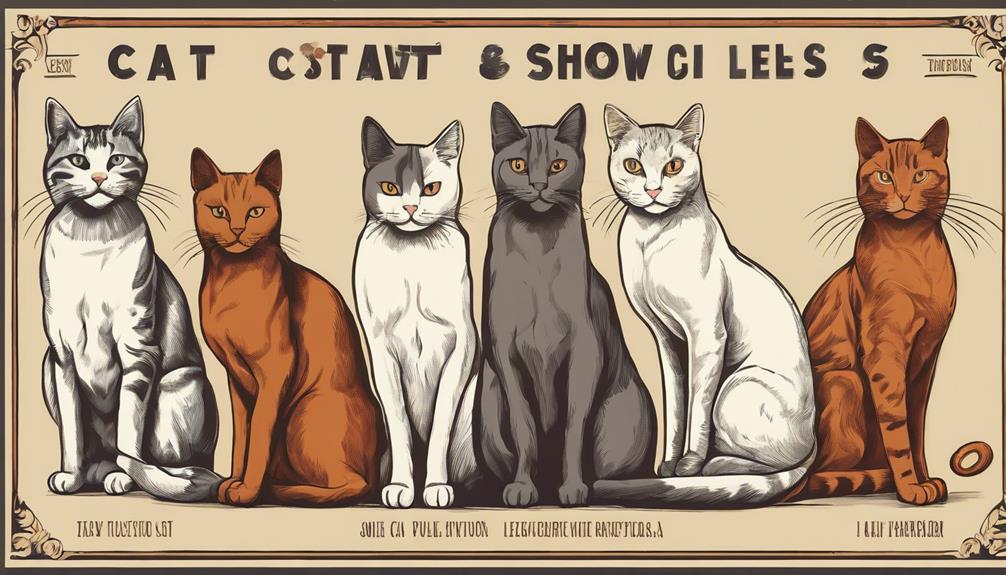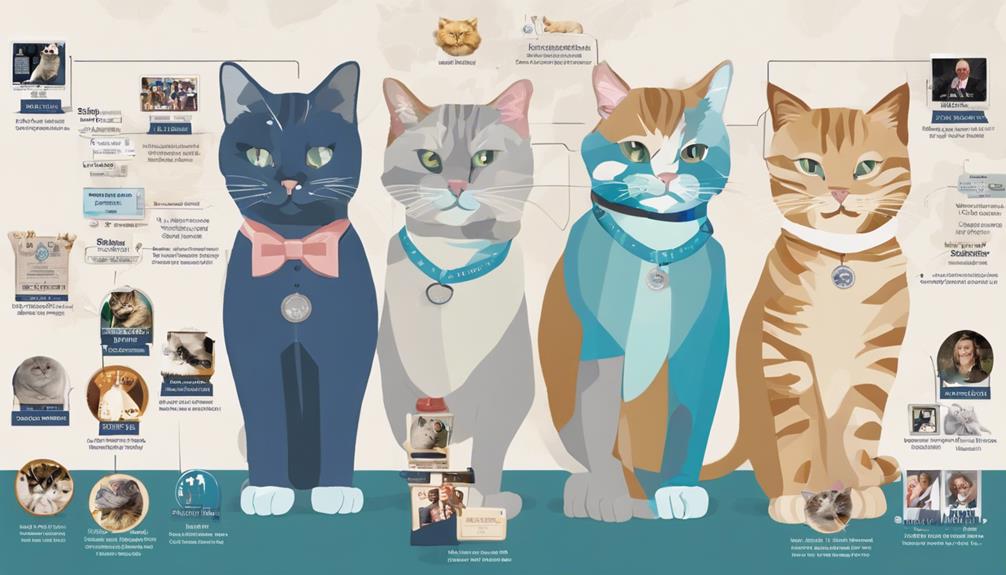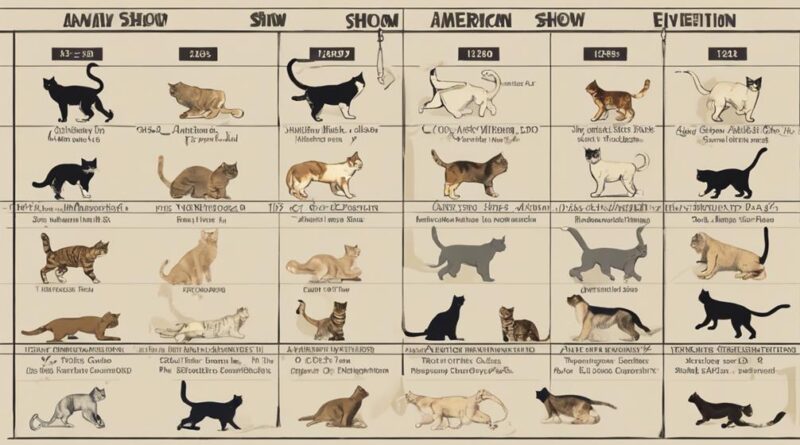Tracing the American Cat Show Evolution
Have you ever wondered how the American Cat Show landscape has transformed over the years?
From its humble beginnings to the sophisticated competitive events we see today, the evolution of cat shows in the United States unveils a fascinating journey filled with intriguing shifts and developments.
As you explore the early foundations and milestones that shaped this unique world, you'll uncover surprising insights that shed light on the captivating evolution of American cat shows, hinting at the untold stories behind the glittering cat show circuits and the impact of changing standards.
Early Beginnings of American Cat Shows
In the early days of American cat shows, enthusiasts from various regions gathered to showcase their beloved felines and promote the appreciation of different breeds. Cat breeds such as the Maine Coon, Siamese, and Persian were among the early stars of these exhibitions. Judging criteria at these shows focused on specific breed standards, including coat color, pattern, body shape, and facial features unique to each breed.
These early cat shows were instrumental in educating the public about the diverse characteristics of various cat breeds. Judges carefully evaluated each feline based on how well they conformed to the breed standards. For example, a Siamese cat would be judged on its striking blue almond-shaped eyes, short coat, and distinct color points on the ears, face, paws, and tail. In contrast, a Maine Coon would be assessed for its large size, tufted ears, bushy tail, and friendly demeanor.
As these shows gained popularity, they not only served as a platform for showcasing different breeds but also helped in the preservation and promotion of purebred cats. Enthusiasts and breeders eagerly participated, striving to improve their breeds and uphold the standards set by cat fancier associations. The early days of American cat shows laid the foundation for the structured and competitive exhibitions that would follow in the years to come.
Establishment of Cat Fancier Associations
The evolution of American cat shows through the early beginnings has led to the establishment of Cat Fancier Associations dedicated to promoting and preserving diverse feline breeds. These associations play a crucial role in the world of cat breeding by overseeing feline registration and ensuring breed recognition.
Cat Fancier Associations serve as the central hub for cat enthusiasts, breeders, and exhibitors. They provide a platform for individuals to register their felines, allowing for a systematic way to track pedigrees and maintain breed standards. Through feline registration, these associations create a comprehensive database that helps in preserving the unique characteristics of different cat breeds.
Moreover, Cat Fancier Associations are instrumental in the process of breed recognition. They set guidelines and standards that define the characteristics specific to each breed, helping to maintain the integrity and authenticity of feline lineages. By establishing these standards, associations ensure that breeders adhere to ethical practices and work towards preserving the distinct traits that define each feline breed.
In essence, the establishment of Cat Fancier Associations marks a significant milestone in the history of American cat shows. Through their dedication to feline registration and breed recognition, these associations contribute to the rich tapestry of diverse feline breeds that grace cat shows and enrich the lives of cat lovers worldwide.
Evolution of Cat Show Standards

Cat show standards have evolved significantly over time, reflecting the changing preferences and priorities of cat enthusiasts and breeders. Judging criteria and showmanship styles have played a crucial role in shaping these standards.
Here are five key aspects of the evolution of cat show standards:
- Inclusion of Health Criteria: Modern cat show standards now prioritize the overall health and well-being of the cats, including factors like weight, muscle tone, and coat condition.
- Emphasis on Temperament: Judges now evaluate cats not only based on their physical attributes but also on their temperament, looking for cats that are friendly, confident, and well-socialized.
- Diversity in Breeds: Over the years, cat show standards have become more inclusive, recognizing a wider variety of breeds and allowing for greater diversity in the competition.
- Adaptation to Trends: Cat show standards have adapted to changing trends in cat breeding, reflecting shifts in popular cat breeds and traits favored by enthusiasts.
- Focus on Ethical Breeding Practices: There's now a greater emphasis on ethical breeding practices in cat show standards, promoting responsible breeding and the well-being of the animals.
Introduction of Breed Categories
Reflecting the evolving landscape of feline competitions, breed categories have been introduced to diversify and enhance the cat show experience. Breed classification plays a crucial role in organizing these categories, ensuring that each cat is judged according to specific show ring standards tailored to its breed characteristics.
When it comes to breed classification in cat shows, each feline is grouped into specific categories based on factors such as coat length, color patterns, body structure, and facial features. These categories allow judges to evaluate cats more effectively by comparing them to the ideal standards set for their breed. Show ring standards serve as a guideline for judges, outlining the desirable traits that cats of a particular breed should possess.
Introducing breed categories has brought a new level of excitement and competition to cat shows. Participants now have the opportunity to showcase their cats within their respective breed groups, competing against others with similar characteristics. This not only adds diversity to the show but also allows for a more specialized evaluation of each cat's conformation and temperament.
Rise of Competitive Cat Exhibitions
With the growing popularity of feline competitions, the landscape of cat shows has seen a notable shift towards the emergence of competitive cat exhibitions. These events aren't just about showcasing breeds but also about celebrating the unique abilities and qualities of each cat.
- Competitive Judging: Judges at these exhibitions assess not only the appearance of the cats but also their behavior, temperament, and overall health. This comprehensive evaluation ensures that the winning cats aren't just visually appealing but also well-rounded in all aspects.
- Feline Agility: Competitive cat exhibitions often include agility courses where cats showcase their speed, coordination, and intelligence. This adds an exciting element to the shows, highlighting the athleticism and skills of these incredible felines.
- Specialty Awards: In addition to traditional judging, competitive cat exhibitions may feature specialty awards for unique categories such as best groomed, most playful, or even best costume. These awards add a fun and creative dimension to the competitions.
- Breed Diversity: These exhibitions often bring together a wide variety of cat breeds, allowing enthusiasts to appreciate the beauty and diversity of different feline types. It's a great opportunity for breeders and owners to showcase their beloved cats.
- Audience Engagement: Competitive cat exhibitions aren't just for participants; they also provide a platform for cat lovers to come together, share their passion, and learn more about different breeds and feline care. The interactive nature of these events makes them enjoyable for everyone involved.
Expansion of Cat Show Circuits
The growing demand for diverse feline experiences has spurred an expansion in the reach and frequency of cat show circuits. Cat show circuits have evolved beyond local events to become more global in impact, attracting participants and audiences from around the world. This expansion hasn't only broadened the competitive landscape but has also enhanced the cultural significance of cat shows.
The increased globalization of cat show circuits has led to a greater exchange of ideas and practices among participants from different countries. This cultural exchange has enriched the overall cat show experience, allowing for the showcasing of diverse breeds, grooming techniques, and judging standards. As a result, cat shows have become not just competitions but also platforms for celebrating the unique beauty and heritage of various feline breeds.
Furthermore, the global impact of cat show circuits has fostered a sense of community among cat enthusiasts worldwide. Participants and spectators alike have found common ground in their love for cats, transcending geographical boundaries to form lasting connections. This sense of camaraderie has strengthened the bond between individuals with a shared passion for felines, making cat shows not just events but also social gatherings that promote unity and mutual understanding.
Influence of Social Media on Cat Shows

The growing influence of social media has revolutionized the way cat shows are promoted and experienced by enthusiasts worldwide. Social media impact has significantly transformed the landscape of cat shows, providing a platform for greater reach and engagement. Here are some key aspects highlighting the influence of social media on cat shows:
- Wider Reach: Social media platforms allow cat shows to reach a global audience, increasing participation and awareness.
- Real-Time Updates: Enthusiasts can now receive instant updates on cat shows, schedules, winners, and behind-the-scenes moments, enhancing online engagement.
- Interactive Contests: Social media enables interactive contests such as 'Best in Show' polls, encouraging audience participation and excitement.
- Breed Promotion: Breed-specific groups and pages on social media help showcase different cat breeds, attracting diverse participants to cat shows.
- Networking Opportunities: Social media fosters connections among cat enthusiasts, breeders, and show organizers, creating a vibrant community around cat shows.
Through these avenues, social media has become an indispensable tool in shaping the modern cat show experience, fostering a sense of community and excitement among cat lovers worldwide.
Future Trends in American Cat Shows
Embracing technological advancements will shape the future trends in American cat shows. Technology integration is becoming increasingly important in modern cat shows. From live streaming the events to using digital platforms for registration and communication, technology is enhancing the overall experience for participants and spectators alike. Judges are also utilizing digital tools to streamline the judging process and ensure transparency in their decisions. This shift towards digitalization not only improves efficiency but also opens up new possibilities for showcasing feline beauty and agility.
In addition to technology integration, sustainable practices are gaining traction in American cat shows. Organizers are focusing on reducing the environmental impact of these events by implementing eco-friendly initiatives such as using biodegradable materials for cat litter and promoting recycling practices. By prioritizing sustainability, cat shows can contribute to a greener future while setting a positive example for attendees.
Furthermore, audience engagement is a key aspect that will shape the future of American cat shows. Organizers are exploring innovative ways to involve spectators in the shows, such as interactive voting systems for favorite cats or hosting educational sessions on cat care. By creating a more engaging and interactive environment, cat shows can attract a wider audience and foster a sense of community among cat enthusiasts. Overall, the future of American cat shows lies in embracing technology, sustainability, and audience participation to elevate the experience for all involved.
Frequently Asked Questions
What Are the Most Common Types of Prizes Awarded at American Cat Shows?
At American cat shows, common prize categories include Best in Show, Best Kitten, and Best Household Pet. Judging criteria often focus on breed standards, grooming, and temperament.
Sponsorship opportunities provide brands exposure to cat enthusiasts, while marketing strategies aim to attract diverse audiences. Prizes such as ribbons, trophies, and pet supplies are awarded based on judges' assessments.
These incentives encourage participants to showcase their cats' unique qualities and skills.
How Have Advancements in Technology Impacted the Judging Process at Cat Shows?
Advancements in technology have greatly impacted the judging process at cat shows. With the rise of virtual competitions and live streaming, judges can now assess cats from around the world without physically being present.
Technology allows for more efficient judging, as judges can use digital platforms to score and evaluate cats in real time. This has revolutionized the way cat shows are conducted, making the judging process more accessible and inclusive.
What Measures Are in Place to Ensure the Well-Being and Safety of the Cats During Cat Shows?
To ensure the well-being and safety of the cats during cat shows, safety measures like secure enclosures and trained staff are in place.
Health checks are conducted before and during the event to monitor their overall welfare.
These measures help create a safe and comfortable environment for the cats to showcase their best qualities without compromising their health and happiness.
How Do Cat Shows Contribute to the Overall Health and Well-Being of Different Cat Breeds?
Cat shows contribute to the overall health and well-being of different cat breeds by promoting breed standards and encouraging responsible breeding practices.
They provide a platform for showcasing well-groomed cats, which helps educate breeders and owners on proper grooming techniques.
Are There Any Specific Regulations or Guidelines in Place for Cat Owners Who Wish to Enter Their Cats in Competitions?
If you're considering entering your cat in competitions, there are specific regulations and guidelines to follow. Training techniques and grooming standards play essential roles in preparing your feline for the show ring.
Entry requirements, such as breed standards and health certifications, must be met. Judging criteria often focus on the cat's conformation, temperament, and presentation.
Understanding these rules and preparing your cat accordingly will increase your chances of success in the show circuit.
Conclusion
You've learned about the fascinating evolution of American cat shows, from their early beginnings to the establishment of breed categories and rise of competitive exhibitions.
The influence of social media has further expanded the reach and popularity of these events.
As cat shows continue to evolve, future trends may include even more diverse breed categories, innovative judging criteria, and increased participation from cat enthusiasts around the country.
Keep an eye out for exciting developments in the world of American cat shows!
